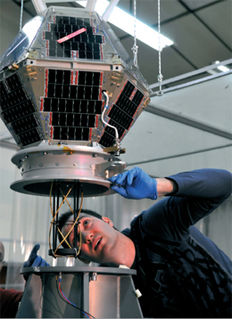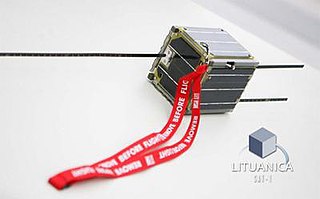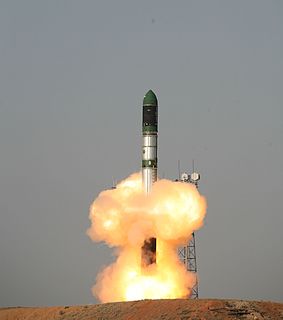
A CubeSat is a type of miniaturized satellite for space research that is made up of multiples of 10 cm × 10 cm × 10 cm cubic units. CubeSats have a mass of no more than 1.33 kilograms (2.9 lb) per unit, and often use commercial off-the-shelf (COTS) components for their electronics and structure. CubeSats are commonly put in orbit by deployers on the International Space Station, or launched as secondary payloads on a launch vehicle. Over 1000 CubeSats have been launched as of January 2019. Over 900 have been successfully deployed in orbit and over 80 have been destroyed in launch failures.
Satellite Internet access is Internet access provided through communications satellites. Modern consumer grade satellite Internet service is typically provided to individual users through geostationary satellites that can offer relatively high data speeds, with newer satellites using Ku band to achieve downstream data speeds up to 506 Mbit/s.

AAU CubeSat was a CubeSat built and operated by students from Aalborg University in Denmark. AAU CubeSat was launched on 30 June 2003 from the Plesetsk Cosmodrome on a Russian "Rockot" rocket.
The Canadian Advanced Nanospace eXperiment (CanX) program is a Canadian CubeSat nanosatellite program operated by the University of Toronto Institute for Aerospace Studies, Space Flight Laboratory (UTIAS/SFL). The program's objectives are to involve graduate students in the process of spaceflight development, and to provide low-cost access to space for scientific research and the testing of nanoscale devices. The CanX projects include CanX-1, CanX-2, the BRIght Target Explorer (BRITE), and CanX-4&5.
ITUpSAT1, short for Istanbul Technical University picoSatellite-1) is a single CubeSat built by the Faculty of Aeronautics and Astronautics at the Istanbul Technical University. It was launched on September 23, 2009 atop a PSLV-C14 satellite launch vehicle from Satish Dhawan Space Centre, Sriharikota, Andhra Pradesh in India, and became the first Turkish university satellite to orbit the Earth. It was expected to have a minimum of six-month life term, but it is still functioning for over two years. It is a picosatellite with side lengths of 10 cm (3.9 in) and a mass of 0.990 kg (2.18 lb).
AMSAT-OSCAR 16, also known as AO-16 and PACSAT, is the in-orbit name designation of an amateur radio satellite of the OSCAR series. It was built by AMSAT and was launched on 22 January 1990 from Kourou, French Guiana on an Ariane 4 launch vehicle. It is in sun synchronous low Earth orbit.

The Nanosat-1B Spanish satellite, designed, developed and operated by the Instituto Nacional de Técnica Aeroespacial, INTA, is a nano-satellite which weighs 22 kg. Its main mission is the communication between remote sites like the Antarctic, the Hespérides warship and Spain.
The Nanosat-1B has fourteen sides, all of them covered by solar panels but the bottom one where the following antennas are installed: a medium gain UHF four wire antenna and two patch antennas.
On the top side there are four UHF monopoles. The solar sensors and the Vectorsol experiment are located in the middle tray, being all the other equipment and experiments located inside the satellite.

F-1 is a 1U CubeSat built by FSpace laboratory at FPT University in Vietnam, in partnership with Angstrom Space Technology Center (ASTC), Uppsala University and NanoRacks LLC. Its mission is to train young engineers and students about aerospace engineering and evaluate an advanced 3-axis magnetometer (SDTM) designed in Sweden by ASTC.
The Technology Education Satellite (TechEdSat) program is a series of CubeSats built by San Jose State University and University of Idaho students in partnership with NASA's Ames Research Center. These satellites have tested communication technology for smallsats, and have contributed to the development of the Small Payload Quick Return (SPQR) concept.
COMPASS-2 will become the second satellite series of the FH Aachen and RWTH Aachen, designed by students. The students of FH Aachen develop the satellite BUS system with the necessary subsystems for power generation, power distribution, data handling and data / power interfaces for the payload. RWTH Aachen students are responsible for the communication hardware on board the satellite.

LituanicaSAT-1 is one of the two first Lithuanian satellites. It was launched along with the second Cygnus spacecraft and 28 Flock-1 CubeSats aboard an Antares 120 carrier rocket flying from Pad 0B at the Mid-Atlantic Regional Spaceport on Wallops Island to the International Space Station. The launch was scheduled to occur in December 2013, but later was rescheduled to 9 January 2014. The satellite is broadcasting greetings of Lithuanian president, Mrs. Dalia Grybauskaitė. The satellite was deployed from the International Space Station via the NanoRacks CubeSat Deployer on February 28, 2014. All LituanicaSAT-1 subsystems have been turned on, tested and proved to be working properly. The mission is considered a complete success by its team of engineers. The mission ended upon the reentry and disintegration of the satellite on July 28, 2014.
iCube-1 is a miniaturised satellite built by the Institute of Space Technology in Pakistan, with an objective to provide a wide range of future experiments in the domain of imaging, microgravity, biology, nanotechnology, space dynamics, chemistry, space physics and various other fields. It can also provide a testbed for developing satellite constellations for specific applications.
Space Tethered Autonomous Robotic Satellite II or STARS-II, was a nanosatellite built by Japan's Kagawa University to test an electrodynamic tether in low Earth orbit, a follow-on to the STARS mission.

EQUiSat is a 1U CubeSat under construction by Brown Space Engineering, an undergraduate student group at Brown University's School of Engineering. On February 6, 2014, NASA announced that it would launch EQUiSat as part of the CubeSat Launch Initiative (CSLI). EQUiSat is currently manifested for a 2018 launch aboard an International Space Station resupply mission. EQUiSat's beacon is designed to be visible from Earth.

UniSat-6 is an Italian micro-satellite developed by GAUSS Srl and launched in 2014. The satellite is built in a 0.4x0.4x0.4m box-shaped bus, optimized for piggy-back launch. All instruments are powered by solar cells mounted on the spacecraft body, with maximal electrical power of 11W. The satellite has no on-orbit propulsion, it makes use of an attitude stabilization system based on permanent magnets.

UPSat is the first satellite manufactured in Greece, by the University of Patras and Libre Space Foundation. It is part of the QB50 mission with ID GR-02. The UPSat mission aspires to be the first satellite launched into orbit made entirely of open-source software and open-source hardware.
Earth Escape Explorer (CU-E3) is a nanosatellite of the 6-Unit CubeSat format that will demonstrate long-distance communications while in heliocentric orbit.
Fox-1B, AO-91 or AMSAT OSCAR 91 is an American amateur radio satellite. It is a 1U Cubesat, was built by the AMSAT-NA and carries a single-channel transponder for FM radio. The satellite has a whip antenna for the 70cm and 23cm bands (uplink), and a second antenna for the 2m band (downlink). Fox-1B is the second amateur radio satellite of the Fox series of AMSAT North America.










